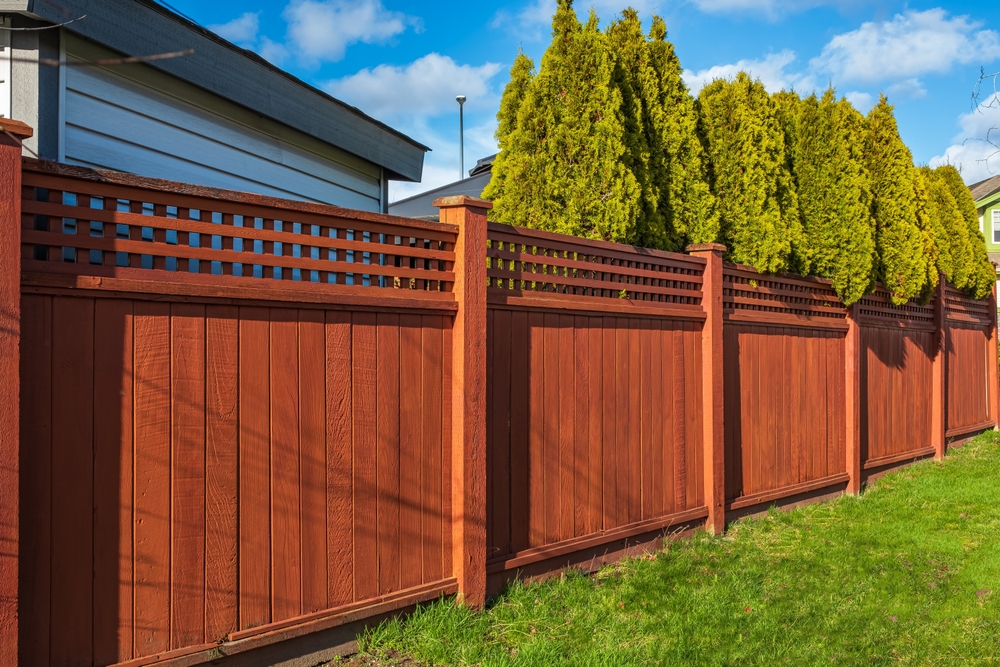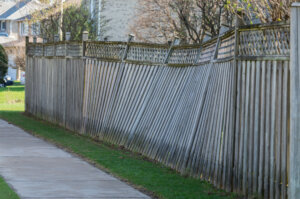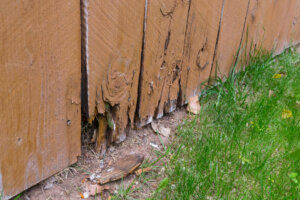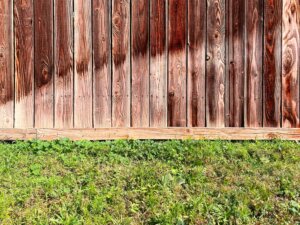While winter in Canada is beautiful, it is also damaging and hard on our homes. Fences, in particular, take a lot of damage over the winter months, often resulting in needing to be replaced come spring. Although there are tips and tricks at maintaining your fence, when it comes to the weather it can be out of our hands. Freezing temperatures and constant snow can cause leaning posts, rotted wood, and weakened foundations. If you’re concerned about the state of yours, look out for these 3 signs your fence needs repairs.
1. It Is Leaning To One Side
Ideally, your fence should be standing upright. If you’ve noticed your fence is starting to lean to one side, this is a clear sign of damage. As fences get older, they naturally start to weaken. If your fence is already weakened by age, winter weather isn’t going to help. Constant high winds and heavy snow falling can further weaken fence posts causing them to lean to one side.
In addition to age, as the ground beneath freezes and thaws over the winter, this can further shift your posts. While a newer fence will be able to handle the moving ground better, older fences will not be able to withstand the pressure. As your fence posts shift in the ground they will become weak and start to lean to one side.
You have two options when it comes to a leaning fence: a temporary fix or a permanent one. You can temporarily fix your fence by adjusting the posts back into place, but this will not undo the damage that has already been done. A permanent fix is to replace your weakened fence with a stronger and more durable material. A fence pro can make recommendations about the best material for your home, based on the weather and environment.
2. It Has Started To Rot
Wood fences need proper maintenance to stay in good condition. Rot is one of the first signs that something is wrong with your fence. Despite your best efforts rot can still occur on wood fences, especially after multiple Canadian winters. Once your fence begins to rot, it will quickly begin to deteriorate. Not only is this unattractive to look at, but the rot also significantly weakens the fence. This means that if your fence has already started to lean, the rot will advance this process.
If caught quickly enough, you can sometimes prevent the rot from spreading throughout your entire fence. The issue with this is that it’s very unlikely you’re going to keep a close eye on your fence during the winter. If rot sets in during the fall, come spring your fence will be beyond repair. Once your fence has been consumed by rot the only thing you can do is replace it.
3. It Has Visible Water Damage
If there’s one thing you take away from this article, it should be that water and fences do not mix well. A long winter exposed to snow, rain and hail can cause water damage to most types of fences. Chain link fences will rust, wooden fences will rot, and vinyl fences can crack when exposed to the elements. Water damage can also weaken the structural integrity of your fence, making it easier to blow over or be knocked down completely.
Another detrimental feature of water damage is that it creates mold and mildew. Mold is a harmful allergen that can impact the health of you and your household. When mold starts to infect your fence, you will have no choice but to replace it. Consider switching to a fence material less prone to mold and rot if you do not want to have to deal with it again in the future.
Below are the average costs of Fences & Gates services across different cities in Canada:
| City | Average | Minimum | Maximum |
| Barrie | $6,104 | $150 | $40,000 |
| Calgary | $6,498 | $125 | $47,000 |
| Edmonton | $7,816 | $147 | $40,000 |
| Hamilton | $1,680 | $250 | $4,500 |
| Oshawa | $4,449 | $420 | $10,700 |
| Ottawa | $8,269 | $123 | $50,000 |
| Toronto | $5,848 | $100 | $50,000 |
| Vancouver | $3,831 | $150 | $30,000 |
*Costs based on 3655 verified Canadian homeowner reviews as of March 202
How to Protect Your Fence From Winter
A new fence can be a beautiful addition to any home. Whether your fence is for protection, privacy or aesthetics, it’s important you know how to protect it so it will last a long time. If you’ve discovered you need to replace your entire fence this year, you’ll want to ensure this doesn’t happen again next year. That’s why prevention is key when it comes to protecting your fence. Follow these simple steps to ensure your fence makes it through many winters to come.
Looks for Cracks and Rot
As mentioned, wooden fences are particularly susceptible to winter damage. Before winter starts, be sure to inspect your fence and look for any cracks or rotting spots. These spots will only get worse as time goes on so it’s important you repair them before winter to help prevent further damage.
Seal Your Fence
Over the course of a long winter, a lot of snow will fall on your fence. As the snow sits on your fence, water will work its way down into the fibers of the wooden. This can lead to mold, mildew and rot. To prevent this from happening, it’s important you have your fence sealed with an oil-based stain before the first snowfall. Sealing should be done annually to help protect your fence. Once done, be sure to clear off your fence throughout winter. The longer the snow sits, the more potential it has to destroy your fence.
Remove Snow Regularly
After a large snowfall, it’s a good idea to clear off the snow on your fence. You want to pay special attention to the space around the bottom. Removing snow from the bottom will help to prevent water damage and maintain the structural integrity of your fence. Remember that fences made from wood, vinyl and aluminum are all susceptible to water damage.
The overall health of your fence will be greatly impacted by the condition it was in prior to winter. By ensuring you properly prepare it for winter, you should have no issues come spring. If you neglected to prepare it, it’s likely your fence will have at least one of these winter-related issues. Connect with a fencing expert to discuss your options about replacing your fence. They can also make recommendations about the best fence materials for harsh Canadian winters so yours will last longer.
Article Updated June 2022



